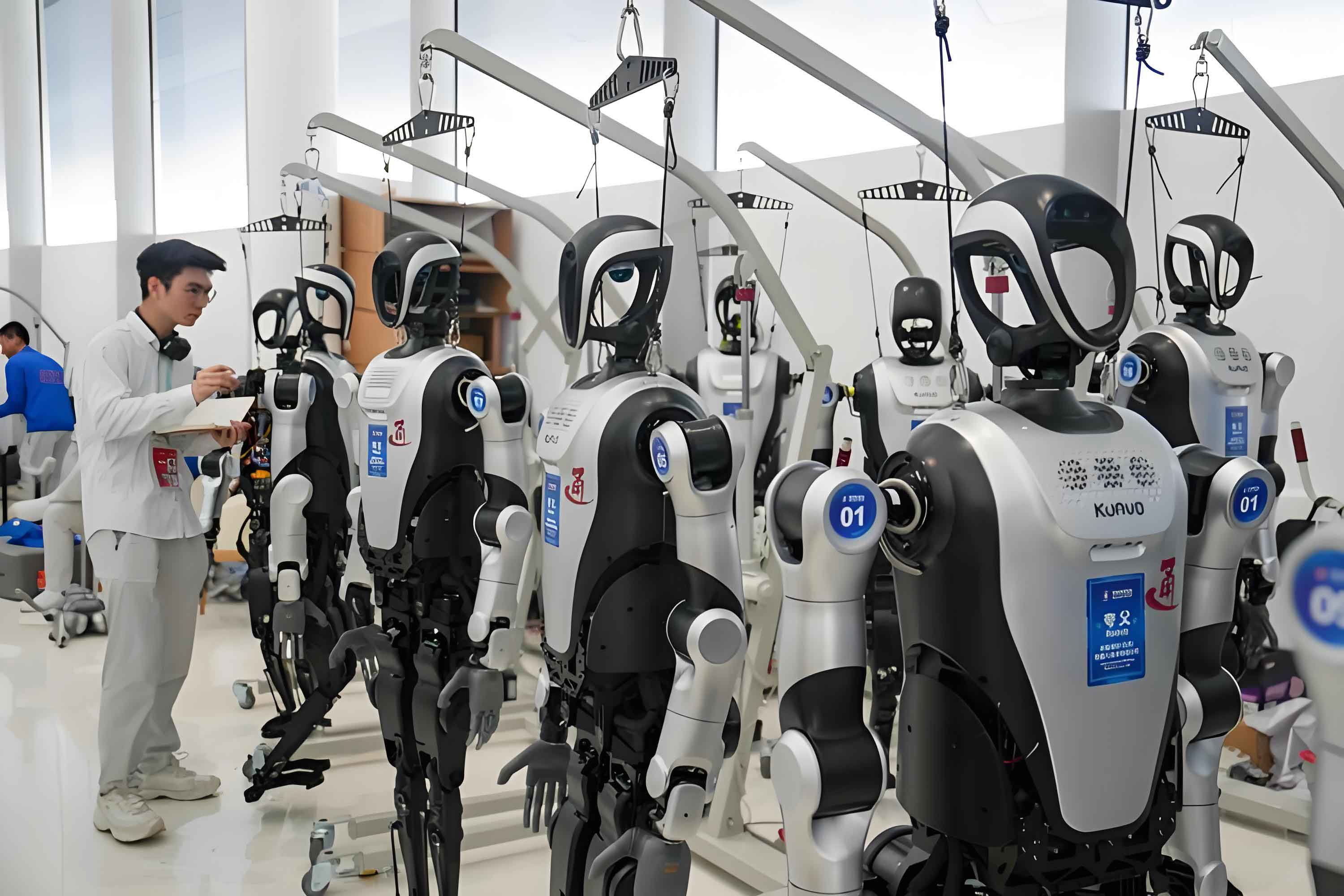In the dawn light of Beijing’s Yizhuang district last April, 38 humanoid robots completed the world’s first dedicated half-marathon for machines. This sci-fi spectacle revealed an industry-wide challenge: participants averaged one joint overheating alarm every 7.6 kilometers, with walking trajectory deviation rates reaching 23%. These technical stumbles formed the basis of Goldman Sachs China’s critical assessment in its latest report: “Humanoid robots are experiencing a technological explosion similar to smartphones in 2007—where flaws coexist with breakthroughs, and chaos mingles with promise.”
1. Global Race: The “Life and Death Sprint” from Lab to Assembly Line
While Tesla’s Optimus tightened its 1,000th bolt at a Texas factory, Xiaomi’s CyberOne recorded its 82nd fall in Beijing. Simultaneously, engineers at KUKA’s laboratory in Augsburg, Germany, debated millimeter-level tactile sensitivity in robotic fingers. This three-continent technological race signals a new competitive arena shifting from outer space to smart factories. Goldman Sachs projects global humanoid robot shipments will exceed 1.4 million units by 2035, creating a trillion-dollar market. Beneath this vision lies a brutal reality: 2024’s commercially available models like Ubtech’s Walker and Unitree’s Go1 average less than 15% daily activity rates, with many becoming high-tech display pieces. As Boston Dynamics founder Marc Raibert observed, “Making humanoid robots truly functional requires crossing not just a technical chasm, but Darwin’s Sea of commercialization.”
At Leader-Drive factory near Beijing, production lines manufacture 300 harmonic reducers monthly. These precision components—dubbed “the chips of robot joints”—determine movement fluidity. Japan’s Harmonic Drive Systems (HDS) once controlled 80% of this market, but Chinese manufacturers are rewriting the rules: 2024 saw China’s specialized humanoid robot reducer shipments surge 470% year-on-year, with new materials reducing weight by 40%. “This mirrors the 2012 smartphone camera wars,” notes Goldman Sachs. Traditional suppliers face challenges from innovators like SCRC using planetary reducers and Kedali whose lightweight PEEK-material reducers secured orders from XPeng.

A more covert competition involves roller screws under 5mm in diameter. These core components converting rotational to linear motion require micron-level precision. Patent barriers by Germany’s Bosch and Japan’s THK once impeded Chinese firms, but Best Precision’s 2024 breakthrough with Wuxi KZX in grinding processes slashed domestic production costs by 60%. “We now iterate designs every three days,” revealed a Best engineer, showcasing lab logs documenting 217 material fatigue tests.
2. Software Revolution: The “Dark Forest” of AI Training
At Shanghai’s Agibot lab, massive LED screens display dizzying data streams—the AGIBOT GO-1 AI model digesting its 9th petabyte of operational data. Dubbed “The Data Devourer” by engineers, it consumes daily factory footage equivalent to 3 million hours of human labor. “Training for humanoid robots is evolving from ‘image recognition’ to ‘unsupervised evolution,'” explains Goldman’s lead analyst. While pre-2024 training relied on simulated data, Ubtech’s “virtual-physical integration” method now optimizes real and simulated data simultaneously, tripling learning efficiency. This birthed unexpected innovations like Figure’s HELIX model, which autonomously developed a fall-cushioning algorithm with code logic even programmers struggle to decipher.
This revolution brings ethical quandaries reminiscent of Habermas’ “technological colonization” theory: When machines master human skills faster than skills can be traditionally inherited, where does civilization go? The humanoid robot industry must navigate these philosophical minefields while advancing capabilities.
3. Supply Chain Undercurrents: The Trillion-Dollar “Arms Race”
At Ningbo SCRC’s headquarters, a “capacity battle map” hangs prominently: green zones mark two existing humanoid robot production lines, while red arrows point to 15 planned by 2026. This “advance-two-steps, watch-one-step” expansion reflects industry-wide caution. “Pre-orders could theoretically push our capacity to the moon,” an SCRC executive stated, displaying spreadsheets packed with Tesla, Xiaomi, and Ubtech logos. “But who dares bet on million-unit capacity? The 2016 industrial robot bubble taught harsh lessons.” Goldman data shows suppliers’ actual capacity plans remain 80% more conservative than public announcements. This restraint fuels innovation—Kedali redirected expansion funds into material research, extending reducer lifespan to 20,000 hours.
From Shenzhen Bay’s observation decks, DJI’s rooftop drone fleets and Ubtech’s humanoid robot formations create sci-fi vistas. Yet industry watchers compare this moment to 2003’s mobile market—Nokia reigned supreme, but Steve Jobs had secretly registered the iPhone trademark. “Humanoid robots won’t replicate smartphones,” Goldman warns. Possible trajectories include:
- Tesla’s automotive manufacturing approach applied to humanoid robots
- Startups creating “robot natives” for vertical applications
- Unseen disruptors—similar to Amazon’s unexpected cloud dominance in 1999
The humanoid robot arena holds paradigm-shifting variables. As Alan Turing noted while cracking Enigma codes 80 years ago: “Machines surpass humans not through imitation, but by creating new possibilities.” The ultimate transformation of this trillion-dollar track remains unwritten, but each overheating joint and errant step brings the industry closer to crossing its Darwinian Sea.